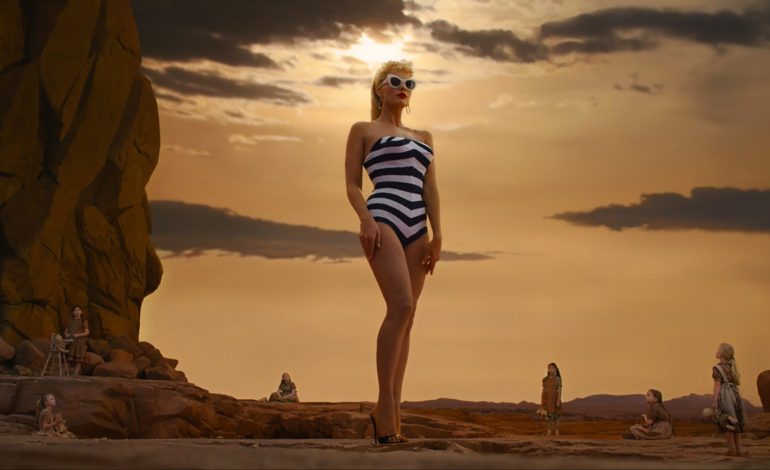

The production of Greta Gerwig’s Barbie has been the talk of casual movie-goers and cinephiles for the past few years, with memes surfacing and trends surrounding the fashion of its premiere on July 21st, which will open the same day as Christopher Nolan’s Oppenheimer.
— ۟ (@heIIcatowner) December 15, 2022
But more than the memes and the star-studded soundtrack bringing in artists like Lizzo, Dua Lipa, and Tame Impala, what is this film offers that grants it a presence on social media before it even premieres? And how does it compare to Greta Gerwig’s previous works?
To paint a very pink picture of the film’s audacious dedication, it was recently revealed that the amount of pink paint used in its production design was so extreme that it caused a widespread shortage worldwide. I think this fact illustrates the film’s extreme level of camp and magnitude of surrealism which likely caught audiences’ attention from the first poster release. The heightened sense of reality has since been carried through the trailers and is dividing fans who either believe the film will bring a more significant twist or will ultimately get caught up in the spectacle of it all. One interview on The Tonight Show With Jimmy Fallon drew audiences’ attention after Ryan Gosling said that the script was the best he’d ever read, and he couldn’t clearly explain the film. This only engaged fans more, and soon, a sense of Barbie culture tore through media platforms and stirred up subsequent criticism for its camp nature.
The trailer drew on the established camp elements and accentuated them since everything from the performances to the cinematography feels like it’s out of a toy box. The story teased a fish-out-of-water theme with Barbie being forced to enter the real world to regain her identity, and Ken comes along as a sort of buddy-cop character. Combined with the bubblegum pop hit “Make Your Own Kind Of Music” by Cassie Elliot (1969), the trailer provided everything we were expecting, ironically disappointing some people who believe that movies aren’t taking themselves seriously these days. People are looking for more original stories with the surface-level releases from Marvel in recent years and the repeated reliance on old franchises like Fast and Furious and Little Mermaid.
Barbie is something they hadn’t seen before– or at least not since Tim Burton ruled over the insanely experimental but heartfelt narratives of the 90s and 2000s. Edward Scissorhands and Alice In Wonderland come to mind when picturing surrealist cinema with a universal fish-out-of-water element like Barbie. But does Greta Gerwig have what it takes to pull off such an audacious genre that must successfully balance true heart and sheer oddity?
The answer will likely be subjective and dissected by both critics and fans upon the film’s release, but what we know so far is that Gerwig has a talent for writing feminist narratives that transcend stereotypes and throw the audience into the world of the character, whether it’s Sacramento (Ladybird, 2017) or civil-war-era Massachusetts (Little Women, 2019). In both films, the protagonists are dynamic, flawed, and unique, which paints the picture that Gerwig loves telling human stories that make the characters grow just as much as the world around them.
So, what do we do when the character is a plastic toy?
Tim Burton and Disney Pixar have proved that you don’t need human characters to tell human stories. For the same reason, Toy Story and Edward Scissorhands resonated with audiences; the journey of uncovering the humanity inside each of us is worth exploring. And I think Barbie will achieve this by undergoing an adventure into the real world. It’ll relay that you don’t need to be human to feel emotions and purpose—you must feel and believe in others.
This, of course, has ties to the coming-of-age genre that Gerwig excels in. For instance, in the case of Lady Bird, conflicts arise because of Christine’s intense emotions, whether it’s anger, love, ambition, or shame. The lesson in her arc is to accept those emotions as a part of her life and use them to preserve the relationships she cares about—mainly those with her parents. Her fish-out-of-water moment happens at the end when she reaches New York and realizes that she can’t create a new identity out of her past without accepting both its peaks and its valleys. The most potent illustration of this moment occurs in the final scene, where her path visually meshes with her mother’s, implying that they both wanted the same peace.
I hope Gerwig brings this kind of emotional depth into Barbie. I don’t enjoy dynamic story worlds outside the human experience (I adore Edward Scissorhands and its pastel depictions of small-town life), but films like these sometimes fall short in giving a larger message. Of course, we can endlessly debate with fans about the genuine need for this “societal commentary” and how sometimes entertainment is just entertainment, but how many of us genuinely enjoy watching those films over and over without any of them reaching for something more?
The social commentary doesn’t have to be a political or pseudo-intellectual undercurrent that you must dig to find after several viewings, nor does it need to be a highway sign at the end credits that tells you what lessons you should have been learning the whole time. Brilliant storytelling is the intricate balance of both, and the message can be as ambiguous as a general feeling that sticks with you after the film that makes you see or think about something differently. And Gerwig has achieved this many times in both her directing style and acting career, so if she can show it through something as lively and vivid as Barbie, it’ll be an impressive feat that cements her label as one of the most dynamic living directors today.
